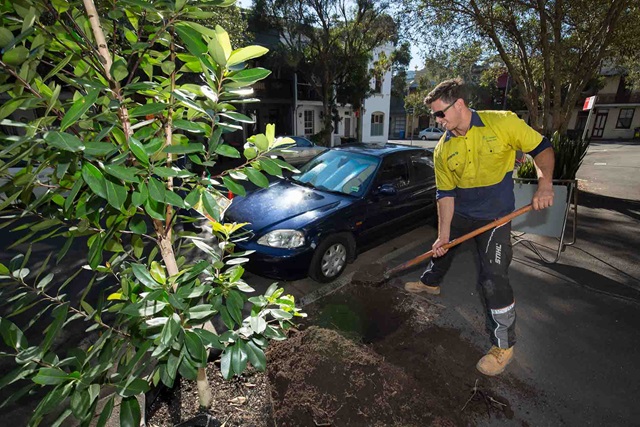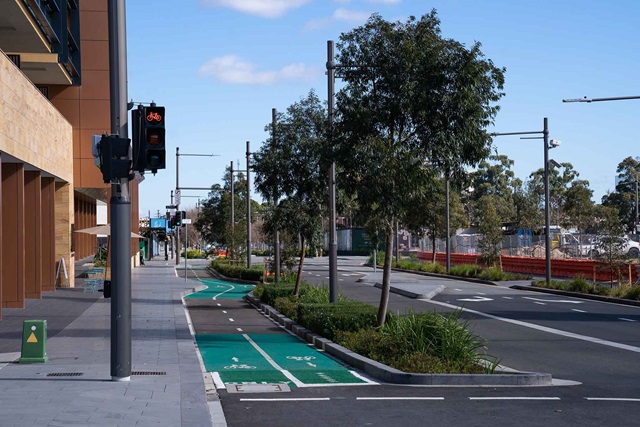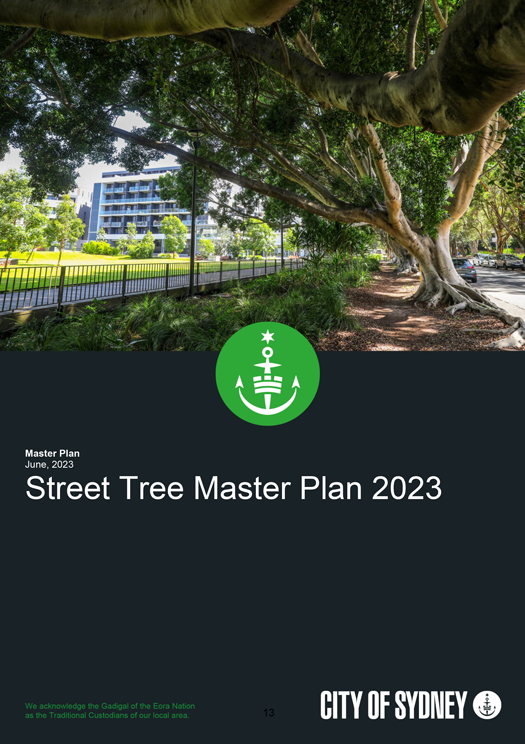Explore the online plan
View a map of tree species selected for planting in each street.
View a map of tree species selected for planting in each street.
This plan provides a coordinated and strategic approach to future planting and ensures our street trees provide a green and resilient future.
The street tree master plan is a critical tool to proactively manage our urban forest. Trees like all living things, grow, age and eventually die. It’s been carefully developed to guide our future street tree planting.

The street tree master plan consists of several key components. The main element is the interactive map, where you can select a street and drill down to find the species proposed for footpaths, constrained areas, potential planted traffic islands and medians. It also links to wider precinct information that gives you more detail on the environment and characteristics of that local area.
There is an option on the map to select advanced filters. This gives the user the option to use more complex filters such as dormancy, canopy spread, species origin, planting arrangements, common and botanic names.
The street tree master plan is a critical part of the City of Sydney’s suite of policies and strategies that we use to proactively manage our urban forest. Trees like all living things, grow, age and eventually die. We’ve carefully developed this plan to guide our future street tree planting. It guides where trees are planted and what species will be used to replace existing trees when they eventually reach the end of their useful lives.
Our focus for future street tree planting responds to the challenges facing our communities and city from the impacts of climate change and the need to build more resilient and sustainable communities. This plan is focused on increasing canopy cover and species diversity, to help us meet our greening and canopy targets, and our core objectives to create a cool, calm and resilient city.
This plan aims to achieve innovative and well considered tree planting solutions for all our streets and laneways. We recognise our streets are critical connections between our homes, workplaces, and the wider landscape. We travel, socialise, and dine on our streets and we interact, living and working next to them every day. We must ensure they:
To develop this plan we have:
This is a plan for the future. It means we use it when choosing species for new planting locations and where a replacement tree is required. Existing trees will not be removed to implement the new species listed in the plan. This will only happen gradually – as existing trees need replacing. Existing street trees will normally be left to grow for their natural life and they will only be removed once they have become a safety issue or an unacceptable hazard. The exception to this might be when major street improvements or infrastructure upgrade works are required. However, tree removal will always be a last resort option.
We hope you find this plan useful and share our passion in making Sydney a green, cool, calm and resilient city.
The Street Tree Master Plan 2023 provides a valuable guide to the planting of street trees throughout the City of Sydney local area. The plan consists of the following key components:
The plan is part of the City of Sydney’s suite of tree management policies. Collectively these provide the necessary tools to effectively manage our urban forest and street trees. Our major tree management documents include:
We’ve also considered the many other existing NSW Government and City of Sydney policies that also influence the future use and development of our streets.

The key objectives of the Street Tree Master Plan 2023 are to:
The original vegetation of the local area was a diverse mix of trees, shrubs and other plants uniquely adapted to various habitats and ecosystems that evolved for millennia. Trees today must contend with a disturbed and altered landscape. Natural soil profiles are rare and paved surfaces interrupt the infiltration of water and nutrients. Roads, buildings and other grey infrastructure combine to change local growing conditions, with reflected heat and wind tunnels a common constraint in many parts of the city. Urban trees, especially street trees, must be tough and capable of withstanding these harsh conditions.
Trees are critical infrastructure in our streets. They are significant to the physical makeup and appearance of our streets and are critical in our overall impression of public spaces. One of the most significant factors that often makes ‘a place’ is its street trees.
The City of Sydney local area covers 26.15 square kilometres with a population of more than 248,000 people. Given its location as the economic and cultural heart of the Sydney metropolitan area, our area is densely urbanised. As the oldest European settlement in Australia, some buildings and landscapes date from the early 1800s and includes many items of historic value.
In broad terms, our local area consists of several distinctive land use types and street typologies that present a variety of opportunities and challenges for street trees. Street tree selection has to respond and relate to the individual circumstances presented within those streets. These key typologies include the following.
The plan is intended for use by:
The way you might use this online resource is outlined below.

Street trees are living things growing in a very unnatural environment. They may behave and respond to the prevailing conditions in a variety of unpredictable ways. No street tree can be perfect all the time and in every situation. It is always necessary to find the ‘best’ fit for the circumstances. Often there will be compromises between the needs of the tree, the desires of the community, the designed intent and the way the tree eventually interacts with the urban environment over its lifetime.
In this plan we have incorporated the following principles and ideals:
The tree species chosen for our street tree planting are the most appropriate trees for the following reasons. They are trees that are:
The United Nations describes climate change as the defining issue of our time. Climate change poses a serious risk to all people, future generations, and should be treated as a national emergency. We are already seeing the impacts of climate change, particularly in our urban areas. Heat records have continued to be broken, with Sydney reaching its highest ever-recorded temperature, and Penrith reaching a staggering 48.9°C during the heatwaves of January 2020. Sydney had many months with below average rainfall in 2019, with its annual total rainfall in the driest 15% of all years recorded. More recently, in 2022 we have experienced the highest annual rainfall on record.
A changing climate has the potential to degrade the liveability of our local area, with more frequent extremes of heat, drought, floods and other severe weather events likely to test the resilience of our communities, and natural and built environments. Many of the trees growing in our local area today may not be adapted to the future conditions we are likely to experience.
Adapting to climate change is critical for a sustainable and forward-thinking approach to managing our street trees. There needs to be a gradual change and adoption of more resilient tree species that evidence shows are better suited to warmer climates, increased heatwave extremes, and drought conditions. We will also investigate and promote the increased use of water sensitive design strategies that may assist to passively irrigate our street trees. This will allow them to better deal with heatwave extremes and drought conditions.
We have developed a comprehensive list of trees species considered most suitable for planting in our local area. We considered and assessed hundreds of potential trees based on their physical traits, expert experience and opinion, biodiversity needs, historical performance, Indigenous ecological knowledge, and their ability to survive into the future changing climate. From this, a list was developed of trees that are determined to be most suitable and desirable for planting in our local area. This wider list covers not only potential street trees but also trees suited to a broad range of other possible locations such as our large public parks and smaller neighbourhood parks, and private properties.
Trees considered to be unsuitable for planting in our local area were excluded from the list. Trees may have been excluded for reasons such as susceptibility to pests or disease, a tendency to be weedy, unlikely to adapt to our future climate, known severe allergens or irritants, and unreliable performance or being short lived.
The species we have selected for this plan is a subset of the wider list. These species are more specifically chosen to fulfil the taxing needs of the street environment.
The list was developed using the knowledge of the City of Sydney’s experienced employees and service providers that have a long history of managing and planting trees throughout the local area. We have also engaged with several industry and technical experts in the field of street tree selection. These included:
More detailed information can be found in the tree species list: development and use report in the Urban Forest Strategy.
In assessing what tree to choose for a given space it is vital to recognise that trees are living organisms. No tree can accommodate all constraints and requirements perfectly. There is no perfect urban street tree. It will always be necessary to compromise and identify the best fit for a space or street.
Our key tree selection objective is still to ensure the selection of the 'right tree for the right place’. In other words, to ensure the selection of the species is optimised for the local environmental conditions and any other constraints of the planting location. The selection of species aims to ensure the tree makes a positive contribution to the environmental, amenity, aesthetic and heritage values of the area and that foreseeable negative aspects are minimised.
When selecting an urban street tree it is vital to consider many important physical and other factors. These relate to the fundamental environmental, functional and aesthetic requirements. The following is the criteria considered in selecting a street tree for a location.
The City of Sydney acknowledges the Gadigal of the Eora Nation as the Traditional Custodians of our local area, and we acknowledge their continuous and deep connection to Country. Country includes the landscape – land, water and sky, the plants and animals, and the relationship between these.
Complex cultural land management practices are embedded in Aboriginal and Torres Strait Islander responsibilities to care of Country. This knowledge and approach to land management and ecology, built up over thousands of years remains important today to the ongoing management of the urban forest as a resilient, thriving, and adaptive living system.
Collaborating with an Indigenous Ecologist through the review of the plan has provided an opportunity to incorporate an Indigenous perspective and knowledge with the following key elements and outcomes:
Never has it been more pertinent to consider our responsibility to look after Country. As espoused by Elder April Bright: “If you don’t look after country, country won’t look after you”.
This plan strives to increase the diversity of street tree species, thereby providing a greater diversity and abundance of food sources, shelter, roosting and nesting opportunities. This has typically been through providing a greater diversity of trees within individual streets, often in combination with increased use of native species, while still catering to some important other needs such as winter solar access, appropriate tree sizes, tree longevity, tree form and habit, ongoing maintenance requirements, heritage and community expectations.
Our local area is a highly artificial, constructed and constrained environment within a diverse cultural and urban landscape setting consisting of interconnected streets, pathways and surrounding buildings and parks. Trees play an important role in the greening of our local area and the environment, and enriching appreciation and cultural experience of a place. There are numerous specific and complex considerations that go into the ultimate selection of our street trees. This includes some of the following considerations that also contribute to how we plan and plant our streets.

The most common street tree planting is achieved by placing trees within the footpath directly behind the kerb, or in landscaped verges between the kerb and footpath. This may be on either side of the street and have a variety of surface treatments including permeable paving, grass or garden beds. Several different planting techniques and placements may be possible and are detailed in our standard technical details.
For each street segment, this plan nominates which tree species is to be planted. It may specify a single species or a species for each side of the street, or an alternating mix of species. Up to three different species have been nominated for footpaths within each street segment. As a result, many streets have now been designed to have a greater mixture of tree species.
For some streets no footpath planting is suitable. This may be due to narrow width of the footpath or shop awnings. Where no footpath planting is possible, planting within the roadway will be prioritised.
The planting of trees within the road or in specifically designed traffic islands or median strips are opportunities to increase our tree canopy within the street network beyond that provided by common planting within the footpath or verge.
In-road planting provides a range of benefits including traffic calming by narrowing roadways and reducing vehicle speeds, opportunity to install trees clear of overhead services, opportunity for passive irrigation and more integrated stormwater management and maximising shade on road pavements by locating trees within the roadway itself.
There are three types of inroad tree planting currently being implemented:
Research has consistently shown that the larger the tree the greater the ecological and community benefits. However, larger trees require larger soil volumes and more physical space above and below ground compared to small trees. Applying the 'right tree for the right place’ principle, smaller trees have a place within our urban forest, particularly in areas where physical space or overhead infrastructure present as overriding constraints.
In some instances, the constraints within a particular planting location will limit the size of the street tree that is selected or would otherwise restrict tree planting altogether. This plan often includes the nomination of what is termed a ‘constrained’ tree species. This nomination provides an alternative species that can be considered by the City of Sydney when conditions prevent the otherwise preferred and anticipated street tree from being installed. These are generally isolated or non-typical situations within a street. This allows a tree to be planted where, in the past, it may not have been possible based on the preferred species not being suitable for such a constrained site.
Some of the instances where the ‘constrained’ species will be planted include where:
This plan represents the intended gradual transition of tree species in streets over a long time frame, as trees gradually need to be removed and replaced. We have accounted for this change through a series of metrics and compared to the previous iteration of the plan produced in 2011.
These metrics show that the 2023 plan draws from a higher overall number of tree species compared to the 2011 plan. This increase is mostly due to more native or locally indigenous trees, and more evergreen trees.
An analysis of the proportional use of these species within the plan shows the 2023 plan represents a swing towards greater use of locally indigenous trees, with less use of exotic and deciduous trees.
The Shannon biodiversity index was used as an overall measure to account for species richness and evenness of the theoretical tree population represented by the plan. The results indicated a greater diversity at the species level, with a slight reduction at the family level. The reduced diversity at the family level is due to a greater reliance on locally indigenous and native trees, many of which are members of the Myrtaceae family.
Results are displayed in the following tables.
For more information about outcomes of the street tree master plan, read more.
Streets within our local area that have similar typologies, land use, and similar underlying soils and environmental conditions have been grouped to form plan precincts.
The specific conditions relating to each precinct are described in summaries.
